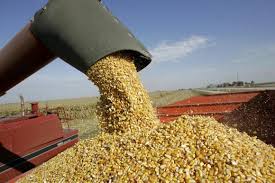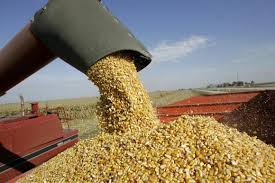
Farmers in Iowa, US are stuffing storage bins with corns and risking potential crop damage from the elements than pay the exorbitant cost of storage elsewhere as well as selling the crops because prices have hit the rock bottom.
Years of bumper crops and low prices have overwhelmed storage capacity for basic foodstuffs and from Iowa to China farmers face similar problems across the globe as world stockpiles of corn and wheat are at record highs.
According to the U.S. Department of Agriculture (USDA), noting the third straight year of historically high surplus, global stocks of corn, wheat, rice and soybeans combined will hit a record 671.1 million tonnes going into the next harvest. And that projected harvest is enough to cover demand from China for about a year.
In the hope of higher prices later, hanging on to their grain are farmers in the United States as farmers are facing a fourth straight year of declining incomes and rising debts. And since the world's top grain producers ponder what to do with so much food and market fundamentals appear to be weakening, the wait for the farmers could be for a long time.
In contrast just a decade ago, droughts in Russia and the United States sent prices soaring which set panic. And policies to encourage more domestic production and increase the volume of storage to improve food security were encouraged by big importers such as China due to the shrinking supply.
China is now selling off hundreds of millions of tonnes of old stocks as it had abandoned that policy last year. And with storage stuffed after a record harvest in 2016. Russia, too, is looking at exporting from state-held stockpiles.
Even more downward pressure on prices in an oversupplied global market would be put by a surge of Chinese and Russian exports.
And this could mean that U.S. farmers will likely get les more and be producing more. Noting the lowest level since 2209, net farm income will fall 8.7 percent this year to $62.3 billion forecasts the USDA.
While in Australia, after farmers produced record crops of wheat and barley, demand for the storage bags has exploded, in Iowa, US, resembling monstrous white caterpillars are the grain-stuffed silo bags are taller than a man. And in Argentina, crops are laying across fields. According to the most recent USDA data in Argentina, wheat production spiked 41.6 percent this year over the 2015/16 season.
Mariano Bosch, the head of Adecoagro SA, which farms more than 225,000 hectares of row crops in Argentina, Brazil and Uruguay, said that since wild animals ranging from rodents to armadillos and even donkeys can be tempted to break in for the grain, there are risks to using the bags.
The company started building electrified fences around their silo bags to keep out cougars and pumas when it expanded its grain plantings in northern Argentina, he said.
"They won't eat the grain. They're just curious," said Bosch, who added that about 40 percent of the company's grain this year is stored in silo bags.
Towering grain silos have sprung up all across the country in Brazil, the world's largest soybean shipper and the second-largest exporter of corn.
(Source:www.reuters.com)
Years of bumper crops and low prices have overwhelmed storage capacity for basic foodstuffs and from Iowa to China farmers face similar problems across the globe as world stockpiles of corn and wheat are at record highs.
According to the U.S. Department of Agriculture (USDA), noting the third straight year of historically high surplus, global stocks of corn, wheat, rice and soybeans combined will hit a record 671.1 million tonnes going into the next harvest. And that projected harvest is enough to cover demand from China for about a year.
In the hope of higher prices later, hanging on to their grain are farmers in the United States as farmers are facing a fourth straight year of declining incomes and rising debts. And since the world's top grain producers ponder what to do with so much food and market fundamentals appear to be weakening, the wait for the farmers could be for a long time.
In contrast just a decade ago, droughts in Russia and the United States sent prices soaring which set panic. And policies to encourage more domestic production and increase the volume of storage to improve food security were encouraged by big importers such as China due to the shrinking supply.
China is now selling off hundreds of millions of tonnes of old stocks as it had abandoned that policy last year. And with storage stuffed after a record harvest in 2016. Russia, too, is looking at exporting from state-held stockpiles.
Even more downward pressure on prices in an oversupplied global market would be put by a surge of Chinese and Russian exports.
And this could mean that U.S. farmers will likely get les more and be producing more. Noting the lowest level since 2209, net farm income will fall 8.7 percent this year to $62.3 billion forecasts the USDA.
While in Australia, after farmers produced record crops of wheat and barley, demand for the storage bags has exploded, in Iowa, US, resembling monstrous white caterpillars are the grain-stuffed silo bags are taller than a man. And in Argentina, crops are laying across fields. According to the most recent USDA data in Argentina, wheat production spiked 41.6 percent this year over the 2015/16 season.
Mariano Bosch, the head of Adecoagro SA, which farms more than 225,000 hectares of row crops in Argentina, Brazil and Uruguay, said that since wild animals ranging from rodents to armadillos and even donkeys can be tempted to break in for the grain, there are risks to using the bags.
The company started building electrified fences around their silo bags to keep out cougars and pumas when it expanded its grain plantings in northern Argentina, he said.
"They won't eat the grain. They're just curious," said Bosch, who added that about 40 percent of the company's grain this year is stored in silo bags.
Towering grain silos have sprung up all across the country in Brazil, the world's largest soybean shipper and the second-largest exporter of corn.
(Source:www.reuters.com)














